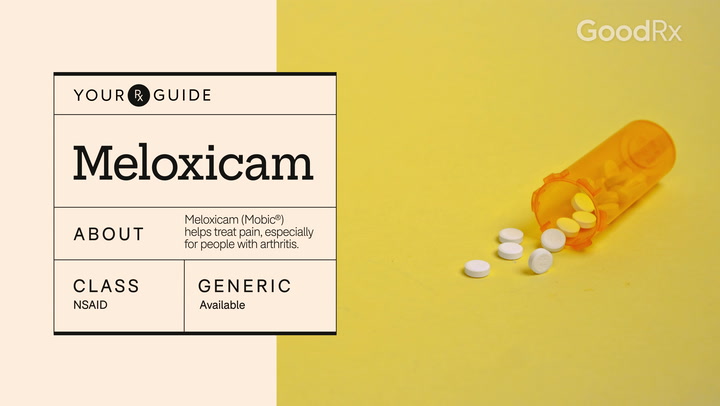
11 Meloxicam (Mobic) Side Effects and How to Manage Them
Key takeaways:
Meloxicam (Mobic) is a nonsteroidal anti-inflammatory drug (NSAID). It’s commonly used to treat pain from different types of arthritis.
Common meloxicam side effects include stomach upset, diarrhea, and swelling. Stomach ulcers and bleeding, kidney and liver damage, and skin reactions are also possible.
Your medical history, how long you take meloxicam, and your dose are important factors when determining your risk for side effects. Talk to your healthcare provider about your individual risk for meloxicam side effects.
Table of contents
Meloxicam (Mobic) is a prescription-only nonsteroidal anti-inflammatory drug (NSAID) that’s commonly used to treat pain from different types of arthritis. NSAIDs like meloxicam work by blocking certain proteins in the body. But this can also lead to unwanted side effects, ranging from mild to severe.
Common meloxicam side effects include diarrhea and stomach upset. More serious side effects can include stomach ulcers, bleeding, and kidney damage.
Not everyone experiences these side effects when taking meloxicam. But it’s important to have the facts in case they do.
Search and compare options
Meloxicam side effects at a glance
Meloxicam can cause a variety of different side effects, but most of them can be managed at home. You may experience some side effects with the first dose, while others can take weeks or months to happen.
Below is a list of some meloxicam side effects that were reported in clinical studies. It’s important to note that this isn’t a list of all possible side effects. Be sure to discuss what to expect with your prescriber.
Common meloxicam side effects include:
Diarrhea
Nausea
Dizziness
Headache
Abdominal pain
Stomach upset
Swelling
Upper respiratory tract infections
Less common but serious meloxicam side effects include:
High blood pressure
Liver damage
Kidney damage
High potassium levels
Stomach ulcers and bleeding
Serious skin reactions
Greater risk of cardiovascular events
Below are 11 side effects of meloxicam in more detail and how to manage them.
1. Diarrhea
Some people taking meloxicam experience diarrhea as a side effect. Researchers aren’t sure why this happens.
Rarely, diarrhea while taking meloxicam could be a sign of something more serious, like colitis (inflammation of the large intestine). If this happens, your diarrhea may be bloody. And diarrhea, along with symptoms like itching, fatigue, and yellow skin or eyes (jaundice), could signal liver problems.
If you experience mild diarrhea while taking meloxicam, make sure to stay hydrated and eat bland foods. If it doesn’t get better in a few days, gets worse, or you develop extra symptoms or bloody diarrhea, contact your prescriber.
2. Upper respiratory tract infections
Another common meloxicam side effect is upper respiratory tract infections (URTIs). URTIs are infections like the common cold which affect your nose, throat, and sinuses. Flu-like symptoms are also possible with meloxicam.
If you happen to get a mild infection while taking meloxicam, rest, and drink plenty of fluids. Ask your pharmacist or prescriber for over-the-counter (OTC) medications you can take safely for symptom relief. Keep in mind that some products have other NSAIDs, which shouldn’t be combined with meloxicam.
If your symptoms aren’t getting better within a week or are getting worse, contact your healthcare team. And if you spot a rash after developing flu-like symptoms, go to the nearest emergency room. This can be a sign of a serious skin reaction (more on that later).
3. Stomach upset
Stomach upset is also a common meloxicam side effect. Meloxicam can cause damage to the stomach by limiting its protective mucus layer. This leaves your stomach more vulnerable to damage from things like stomach acid. In some cases, this can lead to ulcers and bleeding.
Stomach upset can happen at any time while you’re taking meloxicam. You can take your dose with or without food, but taking it with food may help if it’s hard on your stomach. It’s also best to avoid alcohol while taking meloxicam since this could raise your risk for stomach issues.
If you experience stomach pain that’s severe or doesn’t go away, it could be more serious. If this happens, call your prescriber right away.
4. Swelling
Some people may notice swelling in their legs and ankles while taking meloxicam. This isn’t unusual with NSAIDs, since they can cause you to retain water. Older adults and people with kidney problems may be more likely to have this side effect.
The swelling should subside after you’ve stopped taking meloxicam. In the meantime, limiting salty foods may help. Let your prescriber know if swelling becomes a problem during treatment.
Keep in mind: Water retention and swelling can be concerning if you have heart failure. For this reason, people with heart failure should typically stay away from NSAIDs altogether since they can worsen your symptoms.
5. High blood pressure
High blood pressure has been associated with taking NSAIDs like meloxicam. Meloxicam can also interact with certain blood pressure medications, preventing them from working as well.
If you’re taking medication for high blood pressure, you may want to watch your blood pressure closely after starting meloxicam. If your readings are higher than usual, let your prescriber know.
During clinical trials, some people taking meloxicam reported headaches as a side effect. However, headaches were also common in people who didn’t take meloxicam. So it’s possible that these headaches were caused by something else, such as high blood pressure. If you notice a persistent headache, you may want to check your blood pressure and contact your prescriber.
6. Liver damage
While uncommon, meloxicam can possibly cause liver damage. Studies have found that some people taking meloxicam experience changes in their liver function blood tests. If this happens, you may not have any apparent symptoms. In rare cases, liver failure has occurred.
Signs that you might be experiencing liver problems include:
Diarrhea
Itching
Jaundice
Nausea
Upper right abdominal pain
Flu-like symptoms
Contact your prescriber right away if these symptoms develop.
7. Kidney damage
NSAIDs can cause kidney damage by narrowing blood vessels to the kidneys, which limits blood flow. Older adults and people with a history of liver or kidney problems may be at higher risk of kidney damage from meloxicam.
Other risk factors can include:
Dehydration
Combining meloxicam with other medications that can harm the kidneys
Taking higher meloxicam doses
Taking meloxicam for a long period of time
Talk to your prescriber about your risk for kidney damage from meloxicam. And be sure to keep hydrated to lower your risk. If you see changes in urination (e.g., frequency, difficulty, color), contact your prescriber. These can be signs of kidney problems.
8. High potassium levels
Meloxicam may raise potassium levels in the body. This usually isn’t a problem for most people taking meloxicam. But certain factors can raise your risk, including:
Older age
Taking other supplements or medications that can raise potassium levels (e.g., spironolactone)
Having certain medical conditions (e.g., diabetes, heart failure, kidney problems)
High potassium levels can affect your heart, leading to an abnormal heart rhythm. You may not notice any symptoms if your potassium levels are high. But if you do, they may include muscle weakness, nausea, and tingling or numbness. Let your healthcare provider know if these symptoms develop.
9. Stomach ulcers and bleeding
NSAIDs like meloxicam can be hard on your gastrointestinal (GI) tract, causing ulcers and bleeding. This risk tends to be higher if you’re taking an NSAID for a longer period of time, but it can happen at any point during treatment. Other risk factors can include:
History of peptic ulcer disease
History of GI bleeding
Smoking
Older age
Alcohol use
Taking meloxicam with other medications that raise your bleeding risk, including blood thinners and selective serotonin reuptake inhibitors (SSRIs)
You may not have any noticeable symptoms of stomach ulcers or bleeding from meloxicam. But if you do, they can include upper abdominal pain, blood in your vomit, or dark stool. Let your prescriber know right away if this happens.
Taking the lowest effective meloxicam dose for the shortest time can help lower the risk of ulcers or bleeding.
10. Serious skin reactions
Meloxicam warnings include serious skin reactions that can happen after taking it. While rare, these reactions include Stevens-Johnson syndrome (SJS), toxic epidermal necrolysis (TEN), and Drug Reaction with Eosinophilia and Systemic Symptoms (DRESS) syndrome.
If you experience flu-like symptoms followed by a rash, stop taking meloxicam and get immediate medical attention right away.
11. Greater risk of cardiovascular events
NSAIDs like meloxicam have been linked to a greater risk of cardiovascular events, including heart attack and stroke. This risk appears to be greater with higher NSAID doses.
To lower the risk of cardiovascular events, it’s recommended to take the lowest effective meloxicam dose for the shortest time possible. And if you’ve already had a heart attack, it’s best to avoid NSAIDs altogether.
If you develop signs or symptoms of a heart attack or stroke, including slurred speech or chest pain, go to the nearest emergency room.
When should you contact your prescriber about meloxicam side effects? [Contacting your prescriber]
Mild meloxicam side effects can usually be managed easily at home. But if they’re more severe or not going away, it’s best to contact your prescriber.
Get medical help right away if you spot any of the following signs or symptoms:
Bloody or black stools
Dark or brown urine
Swelling of the face or throat
Sudden weakness, dizziness, or confusion
Slurred speech
Chest pain or pain that radiates up to your shoulder
Certain meloxicam side effects may be more likely if you take interacting medications with meloxicam. Share your current medication list with your healthcare team to manage possible interactions ahead of time.
The bottom line
Common meloxicam (Mobic) side effects include diarrhea, swelling, and upper respiratory tract infections (URTIs). More serious effects such as stomach ulcers and bleeding, liver damage, and kidney problems are also possible.You can lower your risk of meloxicam side effects by using the lowest effective dose for the shortest amount of time possible.
Let your healthcare provider know if you experience any side effects that are concerning, won’t go away, or are getting worse. They can rule out serious problems and help you manage your symptoms.
Why trust our experts?



References
A-S Medication Solutions. (2023). Meloxicam - meloxicam tablet [package insert].
Largeau, B., et al. (2021). Drug-induced peripheral oedema: An aetiology-based review. British Journal of Clinical Pharmacology.
Sostres, C., et al. (2013). Nonsteroidal anti-inflammatory drugs and upper and lower gastrointestinal mucosal damage. Arthritis Research & Therapy.
Tonolini, M. (2013). Acute nonsteroidal anti-inflammatory drug-induced colitis. Journal of Emergencies, Trauma, and Shock.
Varga, Z., et al. (2017). Cardiovascular risk of nonsteroidal anti-inflammatory drugs: An under-recognized public health issue. Cureus.
Was this page helpful?
Related Articles
Browse medications
View AllResearch prescriptions and over-the-counter medications from A to Z, compare drug prices, and start saving.














